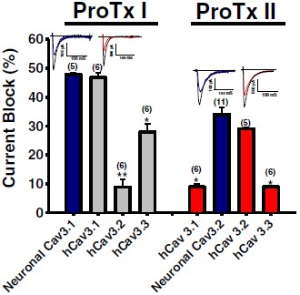Overview
- Middleton, R.E. et al. (2002) Biochemistry 41, 14734.
- Hall, E.O. et al. (2010) FASEB J. 24, 608.14.
 Alomone Labs ProTx-II blocks human NaV1.5 current stably expressed in HEK-293 cells.hNaV1.5 currents were elicited by 50 ms voltage ramp from the holding potential of -100 mV to +60 mV, applied every 10 sec using whole-cell voltage clamp technique. Left: Superimposed traces of hNaV1.5 currents measured under control conditions and after 100 sec perfusion with 50, 100 and 200 nM ProTx-II (#STP-100), as indicated. Inset: Time course of hNaV1.5 current amplitude change as a result of 10, 25, 50, 100 and 200 nM ProTx-II application, as indicated by the horizontal bars. Right: ProTx-II dose response of hNaV1.5 currents (n = 3).
Alomone Labs ProTx-II blocks human NaV1.5 current stably expressed in HEK-293 cells.hNaV1.5 currents were elicited by 50 ms voltage ramp from the holding potential of -100 mV to +60 mV, applied every 10 sec using whole-cell voltage clamp technique. Left: Superimposed traces of hNaV1.5 currents measured under control conditions and after 100 sec perfusion with 50, 100 and 200 nM ProTx-II (#STP-100), as indicated. Inset: Time course of hNaV1.5 current amplitude change as a result of 10, 25, 50, 100 and 200 nM ProTx-II application, as indicated by the horizontal bars. Right: ProTx-II dose response of hNaV1.5 currents (n = 3).
- Middleton, R.E. et al. (2002) Biochemistry 41, 14734.
- Smith, J.J. et al. (2005) J. Biol. Chem. 280, 11127.
- Smith, J.J. et al. (2007) J. Biol. Chem. 282, 12687.
ProTx-II is a peptidyl toxin originally produced in Thrixopelma pruriens, the Peruvian green velvet tarantula. It was identified as a voltage-gated Na+ channel (NaV) blocker which inhibits both tetrodotoxin-sensitive and tetrodotoxin-resistant channels1.
Binding of ProTx-II to an extracellular domain of NaV channel, probably to a hydrophobic site3, inhibits current by shifting the channel activation to more positive potentials1-2.
ProTx-II Inhibits NaV1.2, NaV1.3, NaV1.5, NaV1.6, NaV1.7, and NaV1.8. It is a significantly more potent inhibitor against NaV1.7 than the other NaV channel subtypes1.
ProTx-II was also found as an effective modulator which shifts the voltage dependence activity of T-type Ca2+ channel1.
ProTx-II (#STP-100) is a highly pure, synthetic, and biologically active peptide toxin.

Alomone Labs ProTx-I and ProTx-II inhibit T-type CaV channels.ProTx-I (#STP-400) was applied to mouse thalamic neurons and ProTx-II (#STP-100) was tested on mouse DRGs. ProTx-I blocks native mouse CaV3.1 channel and recombinant human CaV3.1 channel currents similarly, and blocks to a lesser extent CaV3.2 and CaV3.3 channel currents. ProTx-II blocks CaV3.2 channels more potently than the other T-type currents.Adapted from Bladen, C. et al. (2014) Mol. Brain 7, 36. with permission of BioMed Central.
Applications
Citations
- Salari, A. et al. (2016) Sci. Rep. 6, 1.
- Bladen, C. et al. (2014) Mol. Brain 7, 36.

